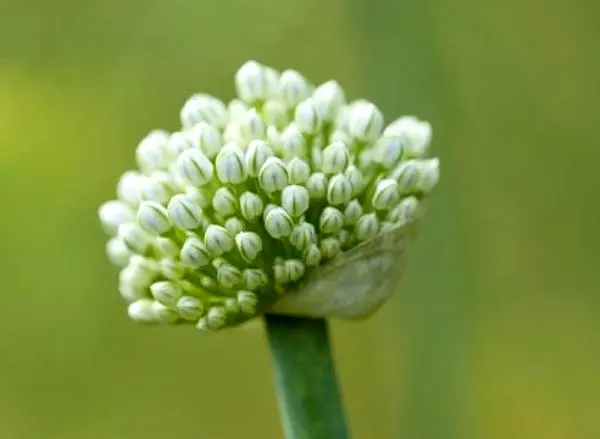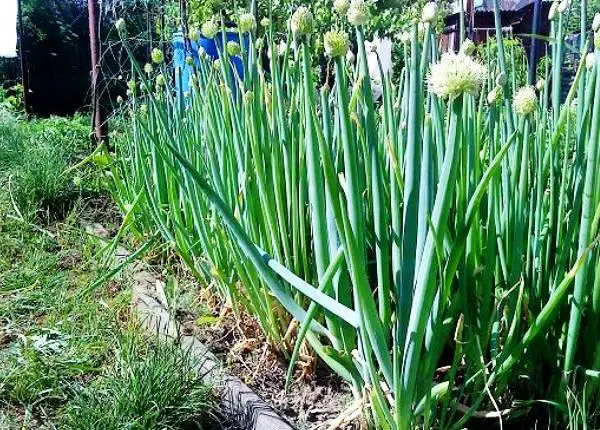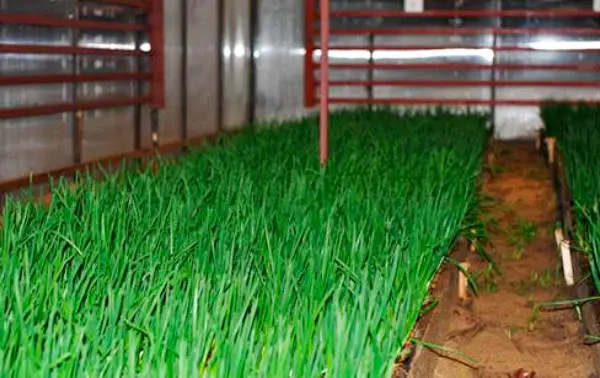Onion batun is a common perennial plant. It is unpretentious in care and painlessly endures prolonged frosts. In most summer cottages, beds with this plant are necessarily present. Even a novice gardener who does not have experience in vegetable growing can sow batun onions without fear for the harvest, growing and caring for it will not require much effort and cost.
Cultivation from seeds
Onion batun is grown exclusively for green leaves. Its feathers are the same fistulate, but larger and longer, with proper care, they can reach 35-42 cm in length and 1,5-2,5 cm in circumference. Batun does not form, like onions, a real, developed head; a so-called false bulb is formed in the soil – a slight thickening. Therefore, it is not suitable for winter storage.
Although in the same place, a batun can be grown up to 8-11 years. However, the highest productivity is observed during the first 3-4 years after sowing. This is due to the fact that one plant during the season can form several daughter onions, as a result of which the crops are unnecessarily thickened and the quality of the crop is significantly reduced.
Onion batun is grown from seeds or by dividing the bush. It is not difficult to independently collect a seed for future planting, since an adult plant throws out several arrows. Of these, one or two of the largest are selected and left to ripen, and the rest are cut off.

Landing
Onion is a photophilous plant, so the beds should be organized in open, well-lit places. Before planting, they dig deep into the ground, remove the rhizomes of perennial weeds and add 4-6 kg of rotted manure, 7-9 g of ammonium nitrate, 8-11 g of superphosphate, 5-7 g of potassium salts per square meter. m. Batun loves moist nutrient soil. Good predecessors are tomatoes, potatoes, cabbage and all legumes.
Batun onions are sown in open ground from early spring to June. Planting and caring for it does not have any fundamental differences. The prepared beds are watered abundantly and the onions are planted to a depth of 1,5-3 cm. The seeding rate is 1,2-1,6 g (350-420 seeds) per 1 sq. M. The distance between the rows is left at least 25-30 cm.
With excessively thickened sowing, seedlings are thinned out at a distance of 6-9 cm. From the second week of July, but not later, all leaves are cut off above the false stem, leaving young light green feathers. By September, the leaves will fully recover, during this period it is not recommended to cut them. Beds with feathers are left for the winter. Dry leaves are removed in the second year by simply raking them with a rake. After 25-32 days, you can harvest the first crop. And after 55-65 days, cut off all the foliage again. In the next 2-3 years, similar activities are carried out. Then the bulbs are dug up together with a clod of earth and transplanted to another place or left for forcing. Often grown early-ripening varieties “April”, “Salad 35” and late-ripening “May”, which is not afraid of even frosty snowless winters. The leaves of “April” are used already in the first half of May, when they grow up to 50 cm.

Agrotechnics
Successful cultivation of batun onions is guaranteed only with sufficient soil moisture, since this onion variety is extremely sensitive to a lack of moisture, and it tolerates its excess well. In a dry area, especially with sandy soil, the batun grows slowly, forms fibrous, coarse and very bitter feathers and quickly puts out rounded, flowery stems. On moisture-intensive, moist soils provided with sufficient nutrients, onion leaves will be tender, with a slight bitterness.
Since the cultivation of batun is advisable only for the sake of green feathers, plantings should be rejuvenated annually. That is, to dig up powerful, two- and three-year-old plants, which eventually form 5-7 arrows. Such bushes are used in greenhouses, greenhouses, film shelters of a simple design, or even on a windowsill at room conditions for forcing. Since this type of onion is optimal for the climate, the temperature during distillation can be as low as 10-13°C. Even left on the beds, he will calmly endure the highest winter frosts. Germination of new feathers in spring begins almost as soon as the soil thaws. At the same time, feathers withstand short-term, return frosts down to -4-7 ° С. Therefore, you can sow the seed as soon as the soil allows. Annual plants are sown in early spring, and perennials – closer to the beginning of summer or autumn, then it has time to germinate before frost. Onions sown in autumn immediately begin to grow greens in spring when the snow melts and the earth thaws.

Like a regular bow, a batun requires a clean fit. Regular loosening and removal of weeds will allow you to maintain sufficient soil moisture and get a better crop for 6-7 years without changing the planting site. When growing onion batun from seeds, it is necessary to apply organic and mineral fertilizers in a timely manner, since during the growing season the plant consumes nutrients from the soil very intensively. Since the land is abundantly enriched before planting, top dressing is applied only in the second year. The first time they fertilize in early spring, mainly with organic matter – mullein, infusion of bird droppings or humus. Subsequent top dressing is carried out with mineral fertilizers, without the introduction of nitrogen-containing components.
Video “Onion batun”
The video shows how much onion batun has grown since sowing. Germination, weight of one plant, crop volume.









